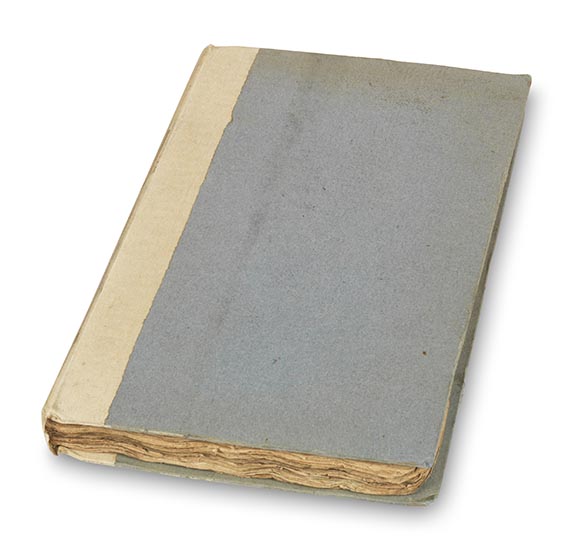32
William Withering
An account of the foxglove, 1785.
Estimate:
€ 4,000 / $ 4,400 Sold:
€ 3,750 / $ 4,125 (incl. surcharge)
Fingerhut
William Withering
An account of the foxglove, and some of its medical uses: with practical remarks on dropsy, and other diseases. Birmingham, M. Swinney für London, Robinson 1785.
- Klassisches Werk über Digitalis
- Unbeschnittenes Exemplar mit der schönen kolorierten Darstellung eines Fingerhuts
- Von einem der größten britischen Botaniker des 18. Jahrhunderts
- Behandelt u. a. die therapeutische Wirkung von Fingerhut bei der „Wassersucht“ und Herzleiden
"Withering was one of the ablest clinicians of his day and one of the most famous men in Europe .. His fame rests on his celebrated work with the foxglove plant .. One of the classics in pharmacology" (Heirs of Hippocrates)
Zweiter Druck der ersten Ausgabe, bei dem die Tafel bereits koloriert ist (siehe Norman). Die Falttafel ist eine seitenverkehrte Kopie aus Curtis' Flora Londinensis . Obwohl Fingerhut bereits ein weit verbreitetes Volksheilmittel war, war Witherings Text der erste, der eine korrekte Dosierung und physiologische Wirkungen festlegte. - "Withering was one of the greatest medical botanists and his book is a pharmacological classic. Before his time, digitalis was a widely used folk remedy, occasionally mentioned in the folk literature, but it was due to him that correct dosages were established and the action of digitalis in dropsy and on the heart became generally recognised” (Garrison/Morton).
EINBAND: Interims-Pappband mit kl. Rückenschild, in moderner Leinenkassette. 22,5 : 14 cm. - ILLUSTRATION: Mit 1 gefalteten altkolorierten Kupfertafel. - KOLLATION: XX S., 1 Bl., 207 S. - ZUSTAND: Tls. schwach gebräunt, sehr vereinz. leicht fleckig, Falttaf. mit hinterl. Falzrissen und kl. Randläsuren. Rückenschild etw. angesplittert. - PROVENIENZ: Weißes Bl. a1 mit 2 Besitzeinträgen: Thomas Brotherton (vermutl. 1785-1868, Armeeoffizier) - "H. (?) R. Cl. Le Baron", dat. London 6.8.1902.
LITERATUR: Garrison/Morton 1836. - Waller 10378. - Blake S. 493. - Heirs of Hippocrates 655. - Norman Coll. 877 und Norman 2255. - Stafleu/Cowan 18.078. - Hunt 676.
Second print of the first edition, with the folding colored plate (see Norman). Though foxglove was already a widely used folk remedy, Withering's text was the first to establish and record correct dosages and physiological effects. Interims card board with label on spine, in modern cloth case. - Partly slightly browned, very occasionally slightly stained, folding plates with backed fold tears and small marginal defects. Label somewhat chipped.
William Withering
An account of the foxglove, and some of its medical uses: with practical remarks on dropsy, and other diseases. Birmingham, M. Swinney für London, Robinson 1785.
- Klassisches Werk über Digitalis
- Unbeschnittenes Exemplar mit der schönen kolorierten Darstellung eines Fingerhuts
- Von einem der größten britischen Botaniker des 18. Jahrhunderts
- Behandelt u. a. die therapeutische Wirkung von Fingerhut bei der „Wassersucht“ und Herzleiden
"Withering was one of the ablest clinicians of his day and one of the most famous men in Europe .. His fame rests on his celebrated work with the foxglove plant .. One of the classics in pharmacology" (Heirs of Hippocrates)
Zweiter Druck der ersten Ausgabe, bei dem die Tafel bereits koloriert ist (siehe Norman). Die Falttafel ist eine seitenverkehrte Kopie aus Curtis' Flora Londinensis . Obwohl Fingerhut bereits ein weit verbreitetes Volksheilmittel war, war Witherings Text der erste, der eine korrekte Dosierung und physiologische Wirkungen festlegte. - "Withering was one of the greatest medical botanists and his book is a pharmacological classic. Before his time, digitalis was a widely used folk remedy, occasionally mentioned in the folk literature, but it was due to him that correct dosages were established and the action of digitalis in dropsy and on the heart became generally recognised” (Garrison/Morton).
EINBAND: Interims-Pappband mit kl. Rückenschild, in moderner Leinenkassette. 22,5 : 14 cm. - ILLUSTRATION: Mit 1 gefalteten altkolorierten Kupfertafel. - KOLLATION: XX S., 1 Bl., 207 S. - ZUSTAND: Tls. schwach gebräunt, sehr vereinz. leicht fleckig, Falttaf. mit hinterl. Falzrissen und kl. Randläsuren. Rückenschild etw. angesplittert. - PROVENIENZ: Weißes Bl. a1 mit 2 Besitzeinträgen: Thomas Brotherton (vermutl. 1785-1868, Armeeoffizier) - "H. (?) R. Cl. Le Baron", dat. London 6.8.1902.
LITERATUR: Garrison/Morton 1836. - Waller 10378. - Blake S. 493. - Heirs of Hippocrates 655. - Norman Coll. 877 und Norman 2255. - Stafleu/Cowan 18.078. - Hunt 676.
Second print of the first edition, with the folding colored plate (see Norman). Though foxglove was already a widely used folk remedy, Withering's text was the first to establish and record correct dosages and physiological effects. Interims card board with label on spine, in modern cloth case. - Partly slightly browned, very occasionally slightly stained, folding plates with backed fold tears and small marginal defects. Label somewhat chipped.
32
William Withering
An account of the foxglove, 1785.
Estimate:
€ 4,000 / $ 4,400 Sold:
€ 3,750 / $ 4,125 (incl. surcharge)


 Lot 32
Lot 32 
